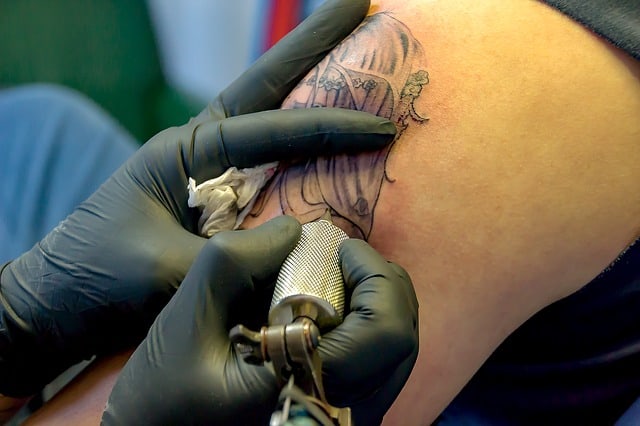When you get a new tattoo, especially from an artist you’ve never used before, there’s always a bit of apprehension due to fear that the work won’t be correct. In fact, in a recent survey conducted by InkedMind.com, we found that 13% of respondents had received what they felt to be a bad tattoo.
Tattoo blowouts are a common problem when getting a tattoo. Unfortunately, there’s little you, as the customer, can do to prevent them. In the article below, I’ll explain what tattoo blowouts are and how they occur.
If you have you gotten a new tattoo and found my article because things don’t quite look right with your new tattoo, then I may be able to help as well. If your new tattoo has blurry lines, ink that appears to bleed around the edges or just look like an overall blotchy mess, it’s likely that you are experiencing some blowout. Below I offer up some suggestions on how you can improve it.
What is Tattoo Blowout and What Causes it?
Tattoo blowouts occur when the artist does not apply the ink in a proper manner. This can be the result of applying too shallow, too deep or at the wrong angle.

Causes for tattoo blowout vary from situation to situation. This makes it difficult to determine whether or not the artist is at fault.
“Human skin is made up of layers and when you’re tattooing what you’re trying to do is get all of the ink in an even layer underneath the skin,” said UK-based professional tattoo artist Holly Astral. “If you’re not putting ink deep enough into the skin the tattoo will kind of fall out and if you go in too heavy the tattoo will blow out.”
Below are the most common causes of tattoo blowout:
Tattoo is Being Drawn on Thin Skin
Parts of your body that contain thinner layers of skin are very delicate. This increases the chances of having a blowout more than areas with thicker layers of skin. The needle might protrude too deep into the lower layers where the tattoo ink can bleed.
Areas of skin that are much more prone to blowouts include: wrists, elbows, knees, ankles, tops of hands and feet, fingers and toes.
Tattoos drawn on these areas should use less ink or else you might get unpleasing results. Therefore it’s important to consider using a more experienced tattoo artist because he or she will know the right amount of pressure to apply to different areas. Novices will most likely not have the same amount of skill applying the tattoo needle.
Using a seasoned artist still may not completely shatter your chances of having a blowout, but it can help.
Tattoo is Being Drawn on Thick Skin
Some areas of the body contain thicker skin. In this case a blowout can occur if the artist accidentally pushes the needle too deeply into the skin. This can cause the ink to bleed into deeper layers of the skin layers and make the tattoo look faded or fuzzy. The artist might also use the needle at an improper angle, which can cause ink to seep into the surrounding areas.
Artists with plenty of experience should understand how much pressure to apply to different areas of skin.
Mistakes by the Tattoo Artist
Unfortunately, mistakes happen—even by the most experienced artists. For example, the artist might be heavy handed and push the needle to aggressively into the skin, letting the ink spread to the neighboring areas. The artist might also pull and tug on the skin too much while applying the ink, thus opening up layers of tissue for ink to spill into.

Still, you should always consider using an experienced tattoo artist with a clean track record of reviews to eliminate the risk of a tattoo blowout.
Although more seasoned artists can usually avoid most of the risk when it comes to causing blowouts, it can be hard to completely prevent for certain areas of skin, and you should not blame your artist immediately if you do have one. Blowouts can happen to even the most experienced of artists.
Blowout can occur with any tattoo, however the risk of it happening does increase when using an inexperienced artist.
Stretching or Pulling of the Skin During Healing
Stretching newly-inked skin can cause the ink to move, especially in areas like tops of hands or elbow ditches where the skin is thin and highly mobile. Areas that have frequent movement can cause some blowout as well.
Does it happen immediately after getting the tattoo?
Anywhere from a few days to several months after getting a tattoo, the ink can begin to spread under the skin to other areas. This makes the tattoos appearance look blurred or smeared. Many tattoo blowouts disappear after the healing process, but sometimes it can take a few weeks for the smudged areas to dissolve throughout the skin layer.
What does Tattoo Blowout Look Like?
Tattoo blowouts appear in several different forms and can range anywhere from very mild to severely pronounced.
Most of the time though, blowouts make the affected areas look smudged or bruised. The lines of the tattoo look like they’ve been blurred, and the ink tends to spread outside the boundaries of the lines.
Think of when you accidentally smear ink from a pen across the page with your hand—this is effectively what many tattoo blowout cases look like.
- TATTOO AFTERCARE ESSENTIAL: Hustle Butter is the original luxury tattoo aftercare product for new and older tattoos. Safe to use right after getting a tattoo to help heal and reduce irritation unlike others. Makes tattoos older tattoos pop and rejuvenates them.
Blowout or Bruising?
As I mentioned above, you can see if you have a tattoo blowout relatively quickly. Many times, people will discover they have possible blowout once they get home and look at their new ink in the mirror.
If you do start to see some possible spreading of the ink within a day or so of when you get your tattoo, don’t panic. There’s a chance what you are seeing is bruising. Bruising is more common on sensitive areas of the body such as the inner arm.
The only thing you can do to determine if a tattoo has a blowout or your skin is just bruising is to wait it out. You should be able to tell with a 4-5 days whether you are experiencing bruising or blowout.
Can blowouts be fixed?
Unfortunately, fixing a tattoo blowout can be very difficult. Since the ink has spread underneath and often between multiple layers of skin, complete removal of all the ink can be nearly impossible. But that doesn’t mean there aren’t workarounds. Below are several possible solutions:
- Tattoo cover ups can work in these situations. The artist can expand on or add ink to the tattoo to conceal the blown out areas.
- Add background shading to the tattoo. Go to an experienced tattoo artist and ask to add some additional shading to the tattoo in order to cover up the areas where there is scarring or blowout. Blowout is usually visible on the outermost edges of the tattoo. To conceal these areas, you can expand on the shading of the existing ink. Choose a color that either compliments or adds to the tattoo’s aesthetic.
- Wait for the ink to fade. In some cases the blowout will fade over time. You can wait a year or so to see if the scarring or ink bleed becomes less prominent or noticeable. It’s possible that the blown out ink may disperse over a wide enough area of skin that it’s no longer visible. If you wait, you’ll give the skin time to fully heal—that way you can know for sure if it is actually a bruise and not a blowout. If it is, the bruise will take some time to heal and the tattoo will look normal after.
- Avoid intense sunlight. Placing newly scarred skin in direct sunlight can cause the tissue to become irritated and dark, making the blowout look worse. For this reason, you should always apply SPF30 sunscreen to the scarred skin area if you go out into the direct sun. Otherwise, keep it covered up with either clothing or shade.
- Consider laser removal. One of the last resorts to removing a particularly bad tattoo blowout is laser removal. Laser tattoo removal can erase the entirety of ink from a tattoo in a few sittings. While the price and time can vary, this usually takes several sittings and ranges from $200 to $500 per sitting.
- Surgical excision. Smaller tattoos can be removed surgically by cutting out the ink and then sewing the skin back together. If the tattoo is larger, it might require skin grafts to replace the skin that’s been cut out. This is the most invasive method of tattoo removal and has minor side effects like infection, skin discoloration, incomplete removal and additional scarring.
- Avoid stretching, pulling or twisting the skin after getting the tattoo. This can worsen the blowout because it aggravates the tender skin tissue as it tries to heal. Overworking the skin may unintentionally cause the ink to disperse into other layers of skin, which gives the appearance of the blowout. During the healing process, do not make sudden twists or pulls until the tattoo is completely healed.
Summary
As you can probably see, tattoo blowout can be caused by a number of reasons, and in many cases they can be avoided or fixed with the right intervention and ensuring you used an experienced, respected artist.
Unfortunately, tattoo blowout can be a very hard problem to fix depending on how severe the skin has been damaged. But again, a good artist can either provide additional shading or cover up the area by adding to the tattoo depending on the size and location of the blowout.


